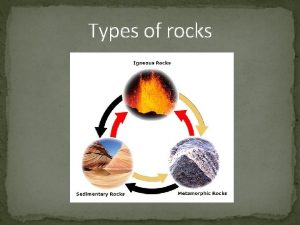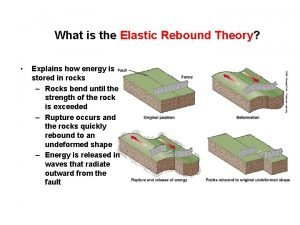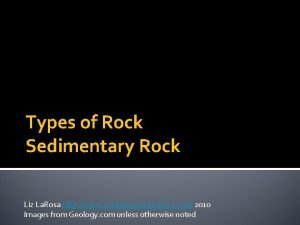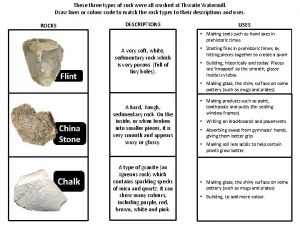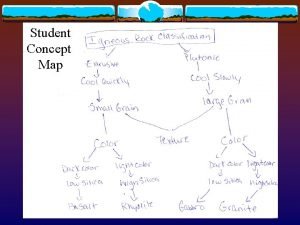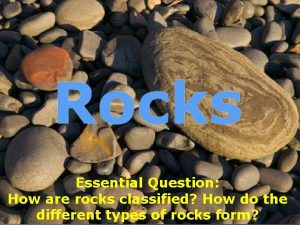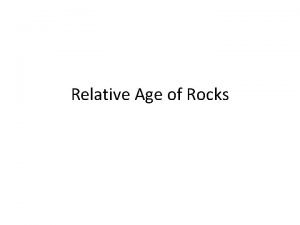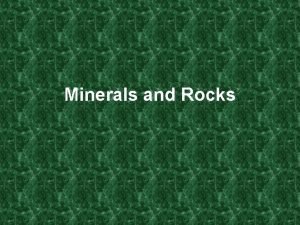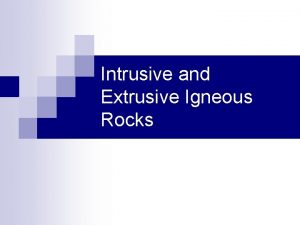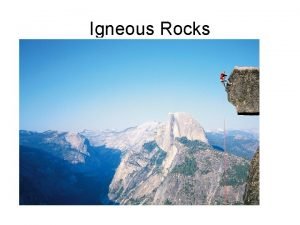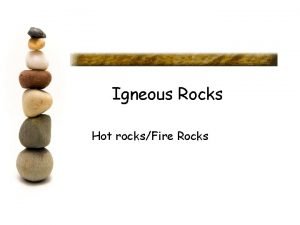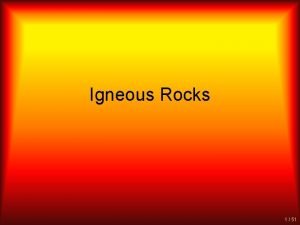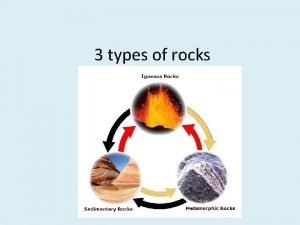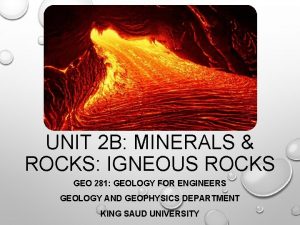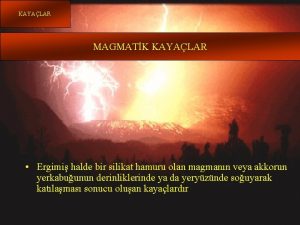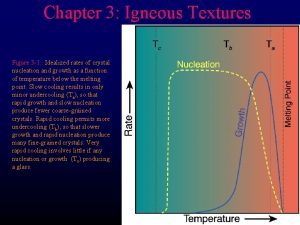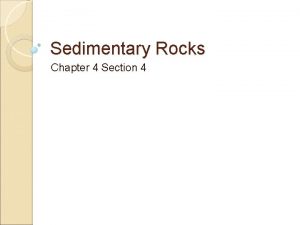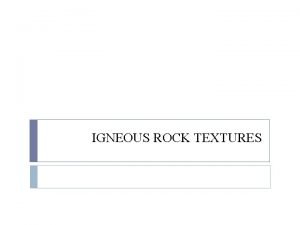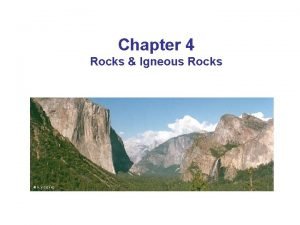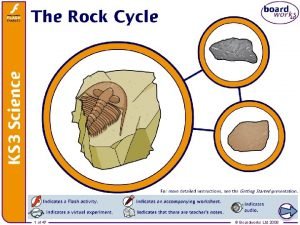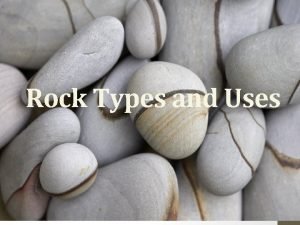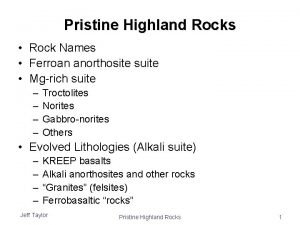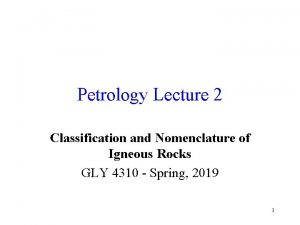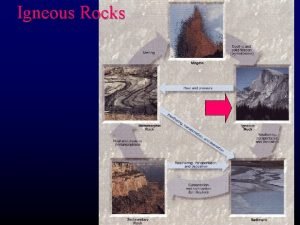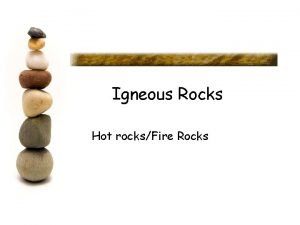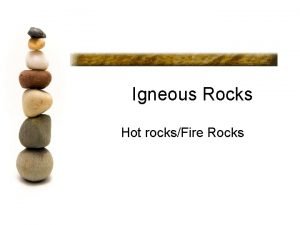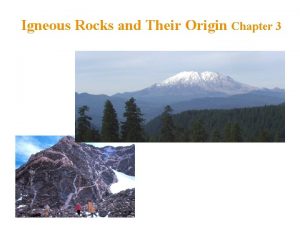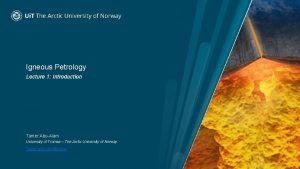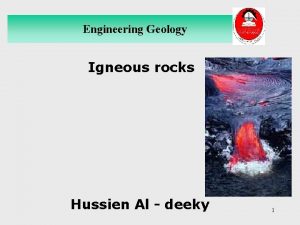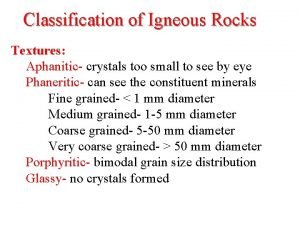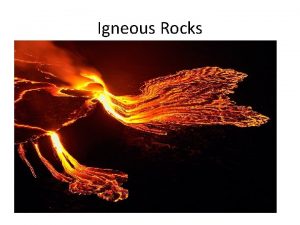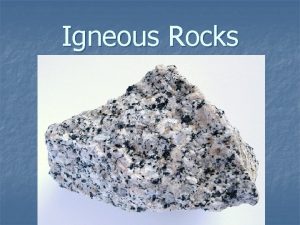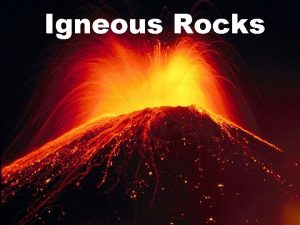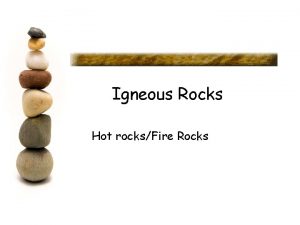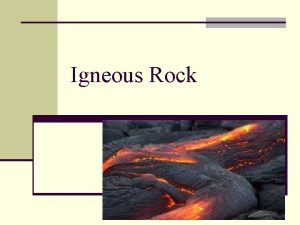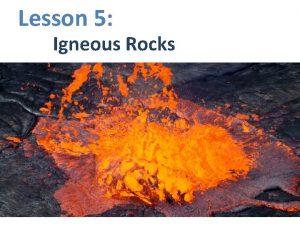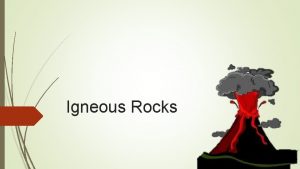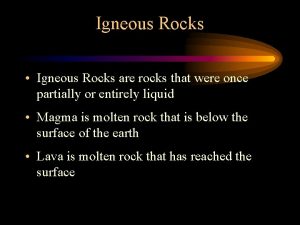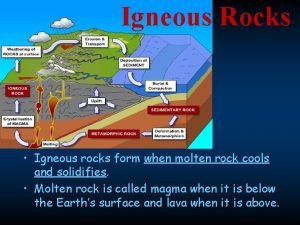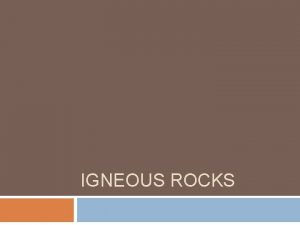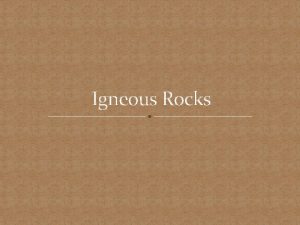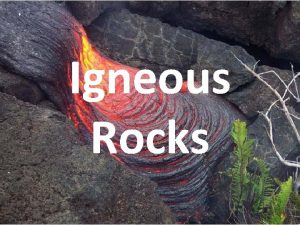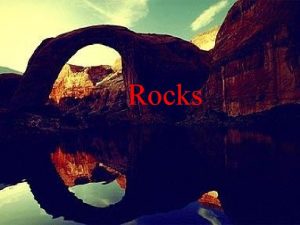Igneous Rocks Igneous rocks form from volcanoes They














































- Slides: 46

Igneous Rocks

Igneous rocks form from volcanoes. They can either form from melted rock deep underground known as magma or melted rock on the surface of the earth known as lava. Why does the magma rise to the surface? It’s a liquid so it is less dense.

There are 2 main groups of igneous rocks. Rocks that form from lava are known as extrusive. They form on the surface of the earth. n Rocks that form from magma are known as intrusive. They form deep underground. n INtrusive

Extrusive rocks cool on the surface of the Earth. Do you think they cool quickly or slowly? Quickly Intrusive rocks cool underground. Do they cool quickly or slowly? Slowly

Igneous Rocks are made up of crystals. What do you think happens to the size of the crystals when they have a long time to grow? They grow big. Which type of igneous rock do you think has the bigger crystals, intrusive or extrusive? Intrusive – it takes longer to cool.

A lava flow on the surface. Extrusive rocks are forming!!

I guess this road will be closed for awhile!

GRANITE An intrusive igneous rock. Granite has big crystals because it cooled SLOWLY

BASALT An extrusive igneous rock Basalt has very small crystals because it cooled QUICKLY

OBSIDIAN Still an extrusive igneous rock This rock cooled really fast!

Let’s Review

Igneous Rock Chart

Intrusive Igneous Rocks

Intrusive Igneous Rock with Large Crystals

Granite


Extrusive Igneous Rocks

Basalt

Compare Intrusive Rocks to Extrusive Rocks: Small Crystals Extrusive Large Crystals Intrusive

Obsidian – NO crystals! Glassy texture


Slow or fast cooling? Large crystal, therefore slow cooling!

How to Identify Igneous Rocks…

1. Color/Density 1. 2. Felsic – light colored, low density Mafic – dark colored, high density


2. Texture • • Coarse-grained – Large crystals Fine-Grained – Small crystals Glassy – No crystals (obsidian) Vesicular –Gas pockets


Vesicular Texture Example = Pumice Gas Pockets

Pumice



Minerals found in Granite

Minerals found in granite.

Igneous Questions

Classify the following rocks as either: volcanic or plutonic and mafic or felsic a b Volcanic and mafic Plutonic and mafic c d Plutonic and felsic Volcanic and felsic

Name the minerals found in Rhyolite

Name the minerals found in Basalt

Q: Name an extrusive igneous rock with a fine texture.

Q: Name an extrusive igneous rock with a fine texture and a felsic composition

• Q: Name an intrusive igneous rock with a coarse texture and a mafic composition

Q: Name the minerals found in Granite.

Q: Name the minerals found in mafic rocks.

Q: Name the minerals found in Andesite.

Name the ELEMENTS found in Mafic rocks. Fe = Iron Mg = Magnesium

Name the ELEMENTS found in Felsic Rocks Al = Aluminum

Why is it unlikely to find Fossils in Igneous Rocks? n Fossils cannot survive the heat from the lava and magma and are destroyed on contact.
 Sedimentary rock song
Sedimentary rock song Igneous rocks metamorphic rocks and sedimentary rocks
Igneous rocks metamorphic rocks and sedimentary rocks What type of rock is this
What type of rock is this How volcanoes form
How volcanoes form Concept map for igneous rocks
Concept map for igneous rocks Igneous rock
Igneous rock Three types of rocks
Three types of rocks Concept map igneous rocks
Concept map igneous rocks Non banded rocks
Non banded rocks Concept map rocks and minerals
Concept map rocks and minerals Principle of inclusions
Principle of inclusions Venn diagram of intrusive and extrusive igneous rocks
Venn diagram of intrusive and extrusive igneous rocks Intrusive vs extrusive igneous rocks
Intrusive vs extrusive igneous rocks Intrusive rock definition
Intrusive rock definition Intrusive vs extrusive igneous rocks
Intrusive vs extrusive igneous rocks Intrusive igneous rocks texture
Intrusive igneous rocks texture What are the physical properties of igneous rocks
What are the physical properties of igneous rocks Intrusive vs extrusive igneous rocks
Intrusive vs extrusive igneous rocks Igneous rock
Igneous rock Phaneritic texture
Phaneritic texture Concept map for igneous rocks
Concept map for igneous rocks Iugs classification of igneous rocks
Iugs classification of igneous rocks Sedimentary rocks examples
Sedimentary rocks examples Characteristics of igneous rocks
Characteristics of igneous rocks Igneous rocks
Igneous rocks Rock cycle labeled
Rock cycle labeled Igneous rock
Igneous rock Igneous rocks
Igneous rocks Is coal clastic organic or chemical
Is coal clastic organic or chemical Sedimentary igneous rocks
Sedimentary igneous rocks Sedimentary rocks
Sedimentary rocks Extrusive igneous rocks example
Extrusive igneous rocks example The rock cycle song
The rock cycle song Inequigranular texture igneous rocks
Inequigranular texture igneous rocks Igneous rocks texture
Igneous rocks texture Igneous rocks appearance
Igneous rocks appearance Properties of igneous rocks
Properties of igneous rocks Basalt and granite difference
Basalt and granite difference Igneous rocks
Igneous rocks Iugs classification of igneous rocks
Iugs classification of igneous rocks Textura
Textura Intrusive igneous rocks crystal size
Intrusive igneous rocks crystal size What is igneous rock
What is igneous rock How igneous rocks are formed
How igneous rocks are formed Iugs classification of igneous rocks
Iugs classification of igneous rocks Igneous rock formation
Igneous rock formation Iugs classification of igneous rocks
Iugs classification of igneous rocks


